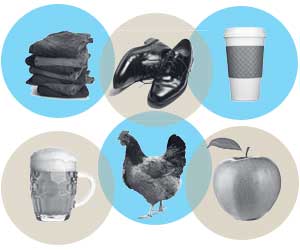THROUGHOUT MOST OF human history, the biggest constraints on economic growth were energy and water. Cities and empires were built on human sweat, the power of draft animals, and the burning of firewood—until the Industrial Revolution unlocked reservoirs of coal and oil. Even then, however, producing food depended on easy access to rivers, lakes, or rainfall. With few exceptions (Roman aqueducts, ancient canals in the Andes), water was just too heavy to transport long distances.
That’s changed in the past century. Far from being a local, static resource, water has become a global commodity, part of a robust trade in what is known as “virtual water.” When Egypt, say, imports a pound of wheat from Australia, it is virtually importing the 156 gallons of water it took to grow it. And when a family in Japan eats a pound of American beef, it’s effectively consuming the roughly 1,800 gallons of water that went into it. According to the United Nations, 450 trillion gallons of water are annually traded as virtual water—about 40 percent of the world’s water consumption. About 80 percent of this traffic consists of foodstuffs, with crops and livestock acting as compact containers carrying water thousands of miles from its source.
At first blush, the exportability of water means we’ve slipped the final constraint on growth. Countries with scarce water supplies can now sustain populations far beyond the limits of what their own farms and fields can support. “It’s a bit like oil,” says Arjen Hoekstra, the Dutch researcher who came up with the concept of the water footprint. “There are nations with a lot and nations without a lot.”
Importing water from wet countries can encourage dry ones to use theirs more wisely; the UN estimates that 90 trillion gallons of water are saved annually this way. (The United States is a net exporter of water by 14.1 trillion gallons a year.) But there’s a downside, too: Now the whole world is in competition for water. Last year’s dramatic rise in food prices and the resulting riots across the globe were due in part to a bidding war over virtual water. Like us, the emerging Asian middle class has a big appetite for meat, which means more farmers are producing grain for cows instead of for people. And then there are biofuels, which are turning water into energy on an unprecedented scale. By one estimate, it takes 800 gallons of water to make one quart of biofuel.
Access to water used to be entirely dependent on local conditions. Now, the virtual water trade allows rich countries to import abundance—and export scarcity. Which means that as Americans consume ever more water in its many forms, we may also be taking food from the mouths of the world’s poor.










